
The Republic of Texas was a sovereign state in North America that existed from March 2, 1836, to February 19, 1846. It shared borders with Mexico, the Republic of the Rio Grande, and the United States of America.
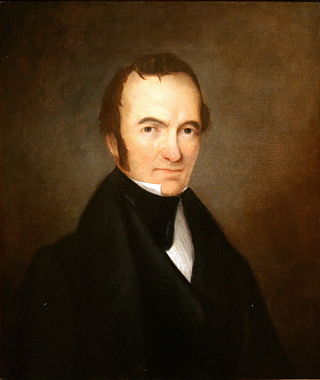
Stephen Fuller Austin was an American-born empresario. Known as the "Father of Texas" and the founder of Anglo Texas, he led the second and, ultimately, the successful colonization of the region by bringing 300 families and their slaves from the United States to the Tejas region of Mexico in 1825.

The Battle of Velasco, fought June 25-26, 1832, was the first true military conflict between Mexico and Texians in the Texas Revolution, colloquially referred to as the "Boston Harbor of Texas" It began when Texian Militia attacked Fort Velasco, located in what was then Velasco and what is now the city of Surfside Beach. The Mexican commander during the conflict, Domingo de Ugartechea, tried to stop the Texians, under John Austin, from transporting a cannon down the Brazos River to attack the city of Anahuac. The Texian Militia eventually prevailed over the Mexicans. Ugartechea surrendered after a two-day battle, once he realized he would not be receiving reinforcements, and his soldiers had almost run out of ammunition..
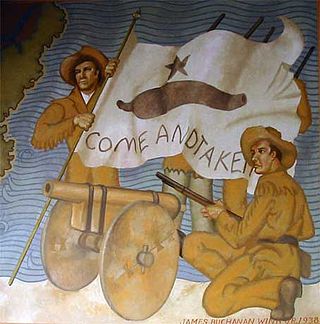
The Battle of Gonzales was the first military engagement of the Texas Revolution. It was fought near Gonzales, Texas, on October 2, 1835, between rebellious Texian settlers and a detachment of Mexican army soldiers.
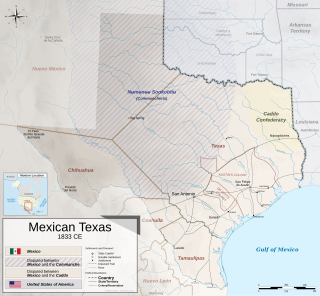
Mexican Texas is the historiographical name used to refer to the era of Texan history between 1821 and 1836, when it was part of Mexico. Mexico gained independence in 1821 after winning its war against Spain, which began in 1810. Initially, Mexican Texas operated similarly to Spanish Texas. Ratification of the 1824 Constitution of Mexico created a federal structure, and the province of Tejas was joined with the province of Coahuila to form the state of Coahuila y Tejas.

James Walker Fannin Jr. was an American military officer, planter and slave trader who served in the Texian Army during the Texas Revolution. After being outnumbered and surrendering to the Mexican Army at the Battle of Coleto Creek, Fannin and his fellow prisoners of war were massacred soon afterward at Goliad, Texas, under Antonio López de Santa Anna's orders. He was memorialized in several place names, including a military training camp and a major city street in Houston.
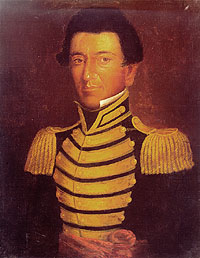
Juan Nepomuceno Seguín was a Spanish-Tejano political and military figure of the Texas Revolution who helped to establish the independence of Texas. Numerous places and institutions are named in his honor, including the county seat of Seguin in Guadalupe County, the Juan N. Seguin Memorial Interchange in Houston, Juan Seguin Monument in Seguin, World War II Liberty Ship SS Juan N. Seguin, Seguin High School in Arlington.
The Grass Fight was a small battle during the Texas Revolution, fought between the Mexican Army and the Texian Army. The battle took place on November 26, 1835, just south of San Antonio de Béxar in the Mexican region of Texas. The Texas Revolution had officially begun on October 2 and by the end of the month the Texians had initiated a siege of Béxar, home of the largest Mexican garrison in the province. Bored with the inactivity, many of the Texian soldiers returned home; a smaller number of adventurers from the United States arrived to replace them. After the Texian Army rejected commander-in-chief Stephen F. Austin's call to launch an assault on Béxar on November 22, Austin resigned from the army. The men elected Edward Burleson their new commander-in-chief.
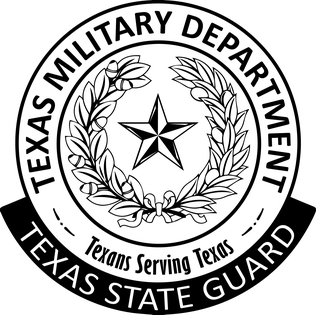
The Texas State Guard (TXSG) is part of the state military force of Texas, and one of three branches of the Texas Military Forces. Along with the other two branches, the TXSG falls under the command of the Governor of Texas and is administered by the Adjutant General of Texas, an appointee of the Governor. The other two branches of the Texas Military Forces are the Texas Army National Guard and the Texas Air National Guard.
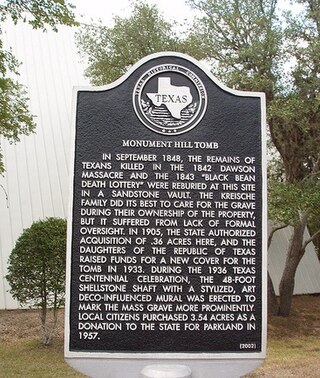
The Dawson massacre, also called the Dawson expedition, was an incident in which 36 Texian militiamen were killed by Mexican soldiers on September 17, 1842 near San Antonio de Bexar. The event occurred during the Battle of Salado Creek, which ended with a Texian victory. This was among numerous armed conflicts over the area between the Rio Grande and Nueces rivers, which the Republic of Texas tried to control after achieving independence in 1836.
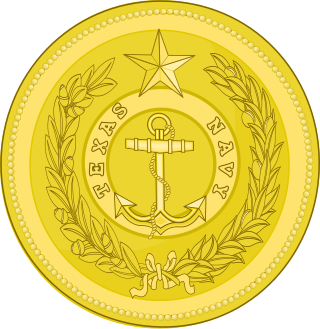
The Texas Navy, officially the Navy of the Republic of Texas, also known as the Second Texas Navy, was the naval warfare branch of the Texas Military Forces during the Republic of Texas. It descended from the Texian Navy, which was established in November 1835 to fight for independence from Centralist Republic of Mexico in the Texas Revolution. The Texas Navy, Texas Army, and Texas Militia were officially established on September 5, 1836 in Article II of the Constitution of the Republic of Texas. The Texas Navy and Texas Army were merged with the United States Armed Forces on February 19, 1846 after the Republic of Texas became the 28th state of the United States.
The Texas Military Forces (TXMF) are the principal instrument through which the Texas Military Department (TMD) executes security policy for Texas, which has the second-largest population and border in the United States.

The Texian Army, also known as the Revolutionary Army and Army of the People, was the land warfare branch of the Texian armed forces during the Texas Revolution. It spontaneously formed from the Texian Militia in October 1835 following the Battle of Gonzales. Along with the Texian Navy, it helped the Republic of Texas win independence from the Centralist Republic of Mexico on May 14, 1836 at the Treaties of Velasco. Although the Texas Army was officially established by the Consultation of the Republic of Texas on November 13, 1835, it did not replace the Texian Army until after the Battle of San Jacinto.
The Battle of Lipantitlán, also known as the Battle of Nueces Crossing, was fought along the Nueces River on November 4, 1835 between the Mexican Army and Texian insurgents, as part of the Texas Revolution. After the Texian victory at the Battle of Goliad, only two Mexican garrisons remained in Texas, Fort Lipantitlán near San Patricio and the Alamo Mission at San Antonio de Béxar. Fearing that Lipantitlán could be used as a base for the Mexican army to retake Goliad and angry that two of his men were imprisoned there, Texian commander Philip Dimmitt ordered his adjutant, Captain Ira Westover, to capture the fort.
Philip Dimmitt (1801–1841) was an officer in the Texian Army during the Texas Revolution. Born in Kentucky, Dimmitt moved to Texas in 1823 and soon operated a series of trading posts. After learning that Mexican General Martín Perfecto de Cos was en route to Texas in 1835 to quell the unrest, Dimmitt proposed that the general be kidnapped on his arrival at Copano. The plan was shelved when fighting broke out at Gonzales, but by early October, 1835, it had been resuscitated by a group of volunteers at Matamoros. Not knowing that Cos had already departed for San Antonio de Bexar, this group decided to corner Cos at Presidio La Bahia in Goliad. Dimmitt joined them en route, and participated in the battle of Goliad.

Manuel Flores served as a volunteer in the Texas army in 1835–1838. Fighting and commanding, he rose through the ranks to reach sergeant status during the fight for Texas independence and was commissioned a captain during the Republic years.

John Henry Moore was an American soldier, farmer and early Texian settler. Moore was one of the Old Three Hundred first land grantees to settle in Mexican Texas and fought in Texas Revolution, most notably leading the rebels during the Battle of Gonzales, the first military engagement of the rebellion.

The Texas Army, officially the Army of the Republic of Texas, was the land warfare branch of the Texas Military Forces during the Republic of Texas. It descended from the Texian Army, which was established in October 1835 to fight for independence from Centralist Republic of Mexico in the Texas Revolution. The Texas Army was provisionally formed by the Consultation in November 1835; however, it did not replace the Texian Army until after the Battle of San Jacinto. The Texas Army, Texas Navy, and Texas Militia were officially established on September 5, 1836, in Article II of the Constitution of the Republic of Texas. The Texas Army and Texas Navy were merged with the United States Armed Forces on February 19, 1846, after the Republic of Texas became the 28th state of America.
The Texas Militia are the militia forces of the State of Texas. It currently consists of the Texas Army National Guard, Texas Air National Guard, and Texas State Guard. It is administered by the Texas Military Department under command of the Texas Adjutant General. Since 1846, the Texas Militia constitutes the entirety of the Texas Military Forces.














